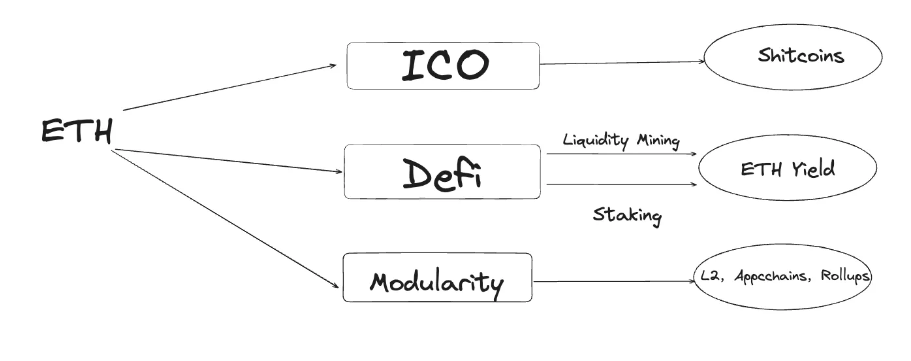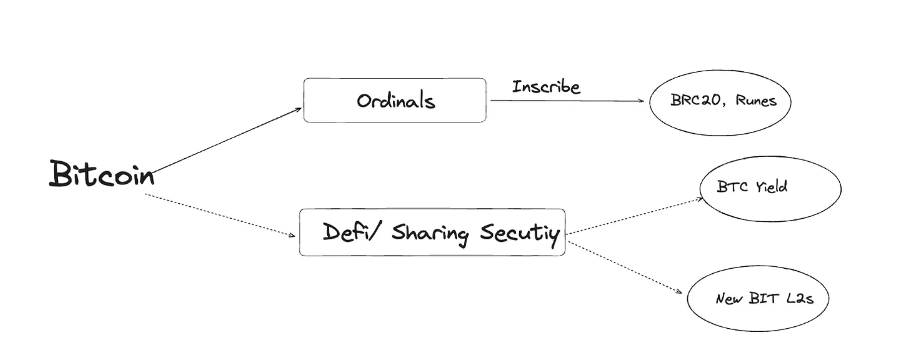What kind of Bitcoin ecosystem do we need after the inscription era?
Author: @xingpt, NP Hard
In the cryptocurrency industry, for technology-type projects, we often need to distinguish between short-term narratives and long-term value to identify which types of projects are speculative bubble assets and which projects have long-term technical value. Of course, good projects can also embody both popular narratives and long-term value, while speculative bubble assets are not without value.
This article mainly discusses the speculative logic of the future Bitcoin ecosystem, but before that, let's take a look at how Ethereum, the most successful player in the speculative game, has developed its narrative.
ICO - Creating Fair but Useless Assets
When Ethereum first emerged, it needed to find an independent positioning separate from Bitcoin and its derivatives, which could support smart contracts to run various applications. The first type of application was ICOs, emphasizing fair token launches, i.e., raising ETH and giving users ERC20 tokens in Ethereum format. The low market value of new coins led to a price surge early on, resulting in the first asset speculation frenzy for Ethereum—the ICO boom.
Although looking back now, 99% of ICO projects have no value, the speculation around ICO-type assets solidified Ethereum's product positioning as an application launch platform, later packaged as the cooler-sounding "world computer."
DeFi and NFT
After experiencing a downturn in 2018 and 2019, Ethereum's last bull market from 2020 to 2022 mainly went through two rounds of mainstream speculation: one was DeFi-type assets, where the underlying product logic was to use Ethereum's native ETH as a "shovel", providing ETH liquidity in various lending, DEX, and derivatives protocols to exchange for project tokens. Unlike ICOs, ETH was no longer used as investment capital but as collateral, giving users the experience of: I can obtain new tokens for free, quickly capturing users' attention with the "freebie" mentality.
However, the model of selling useless assets similar to ICOs continued through the speculation of NFTs, which have several characteristics: "useless" - allowing for greater speculative space, "low liquidity and low market value" - early participants can gain huge profits, "fair" - everyone has the opportunity to participate except whitelist users. (Note: This discussion does not delve into the cultural dissemination differences between NFTs and ICOs, but rather explores the similarities in asset speculation.)
Meme
Although Shib and the zoo market opened the door to meme play, it wasn't until the emergence of the Pepe series that memes became a separate track. However, the current problem with memes is that it is difficult to accommodate multiple large-cap projects; only 1-2 leading projects can reach a market cap of over 1 billion. Therefore, the driving force to boost Ethereum's own market cap is still insufficient.
From the same perspective, we can also observe the reasons for ETH's underperformance in this round, lacking low liquidity assets like NFTs that can be sold and not having the functionality of a "shovel." Arb/OP/Stark, etc., do not provide you with the opportunity to stake ETH to mine Layer 2 native coins; only exceptions like Manta and Blast exist, and the upper limit of coins mined through restaking does not reach the market cap of public chain Layer 2. Thus, ETH has weakened this round. For ETH, standout projects like Celestia have maximized the "shovel" attribute through modular narratives. In terms of "junk" assets, Solana has also introduced meme projects like Bonk and Wif that have seen significant price increases, while various airdrops in the Solana ecosystem, such as Pyth, Jupiter, and Jito, have also given SOL some "shovel" attributes.

For the Bitcoin ecosystem, the biggest change in this market cycle is the issuance of "junk" assets directly on Bitcoin for the first time, which also has the attributes of low liquidity, fair distribution, and low market value. The question is, how can Bitcoin continue to play in the post-inscription era?
Following the logic of using Bitcoin as a "shovel," here are a few hypotheses.
Staking Bitcoin for Yield
One of the leading projects in the Bitcoin ecosystem, Babylon, offers BTC Staking, aiming to achieve permissionless staking on the Bitcoin network to ensure the security of the issued Cosmos public chain through slashing. Using Bitcoin as an underlying yield-generating asset and securing public chain safety with the Bitcoin network are both compelling narratives. Therefore, Babylon has been highly sought after by major VCs in the primary market. However, to enable Bitcoin to play its shovel role, two conditions need to be met: first, the PoS coins mined through the Babylon protocol must have sufficiently high value and quantity; second, the amount of Bitcoin staked through the Babylon protocol must also meet a certain scale. If the TVL is too low, the narrative of Bitcoin network security will not hold. Both conditions require top-tier business development resources to promote and need to exert effort simultaneously in both the Bitcoin and Cosmos ecosystems, which is no small task. Projects looking to emulate Babylon need to consider whether they have the capability to raise over $100 million.
Staking Bitcoin for Mining
Staking Bitcoin for mining is a cold-start method adopted by many emerging Bitcoin Layer 2 projects, such as BSquare and MerlinChain. However, for Bitcoin holders, there are two significant issues: first, security. Bitcoin deposited into Layer 2 networks through cross-chain bridges requires trust in the security of Layer 2 network contracts and nodes, which represents a noticeable downgrade in security compared to the Bitcoin network; second, operational inconvenience. Unlike Celestia, which is inherently a Cosmos-based chain, users staking TIA can receive airdrops from multiple projects. In contrast, mining on Bitcoin Layer 2 requires users to navigate between different protocols, making the experience user-unfriendly and introducing many operational risks.
Another challenge is the issue of yield. The value of the chain mined as a shovel is also worth considering. If the annualized yield is not above 10% or even 20%, it is difficult to attract large Bitcoin holders to take the risk of mining new chain tokens.
Therefore, projects adopting this model need to act quickly to capture high-risk preference Bitcoin holders among the limited number of large holders (which is not a high percentage) and also need to enhance the value of their native tokens, including listings and attracting ecosystem projects, which is more favorable for projects with experience in cryptocurrency entrepreneurship or asset management.
Using Bitcoin for Financing and Issuing "Junk" Assets
The reason "junk" assets seem "useless" yet have buyers is due to their highly innovative narrative methods. The narrative of inscriptions speaks to the revival of Bitcoin, while NFTs play with cultural crossover. Currently, Runes have the most substantial groundwork, with the founder being Casey from Ordinals, and various community plays similar to RSIC are continuously emerging. The project team of Merlin, RCSV, once issued the BRC420 blue box, which can be seen as starting from the issuance of new assets, focusing on speculative assets, and ultimately returning to a larger infrastructure story.
Other newly launched Bitcoin Layer 2 public chains and cross-ecosystem public chains similar to Babylon may need to consider not only how to create a more decentralized and secure Layer 2 public chain (as the narrative foundation for orthodox projects) but also how to create new asset classes and how to distribute assets more innovatively and fairly, rather than simply absorbing Bitcoin from users for airdrops.

So, how to "package" a perfect Bitcoin ecosystem infrastructure project?
First, we hope to allow Bitcoin users to stake in our protocol without trust, without using cold wallet funds for transfers, utilizing Bitcoin's native underlying verification logic, similar to Bitcoin Covenant, DLC, etc.;
Second, we hope that the interest or new assets obtained from staking can be exchanged for Bitcoin in some way, generating a relatively attractive annualized yield from a Bitcoin perspective;
For degens, the newly issued assets should have a relatively fair participation method, able to limit the funding advantages of large holders and reward early core users in the community. I have also elaborated on this topic in my previous article (The Best Time to Invest in Web3 Has Arrived, What Kind of DApp Applications Do We Need?).
Finally, we should participate in open-source community building as much as possible, contribute to the basic development tools and documentation for Bitcoin, and reward the open-source community, etc. Giving back to the community is an important non-technical means of gaining legitimacy, even more important than the technical means themselves.
In the next article about the Bitcoin ecosystem, I will discuss how the Bitcoin ecosystem can develop from a technical path perspective and how to find the ecological positioning of Bitcoin projects.










